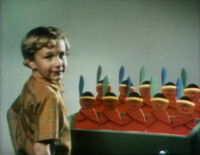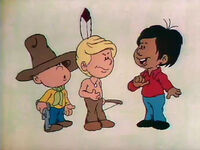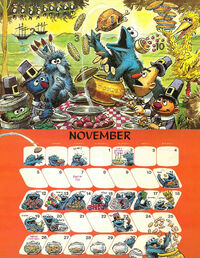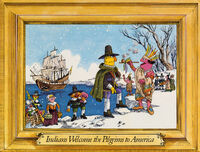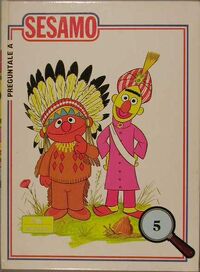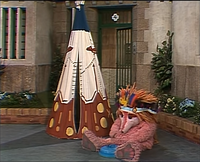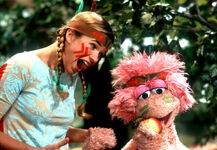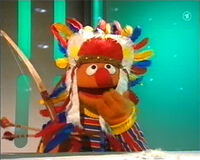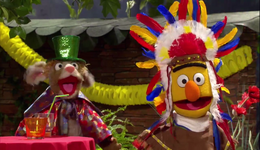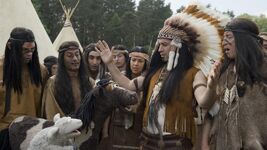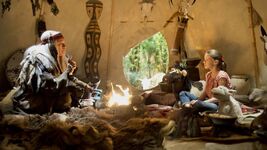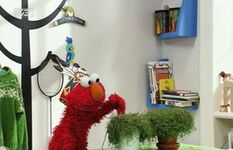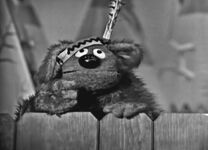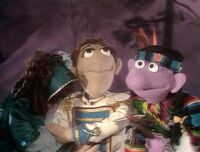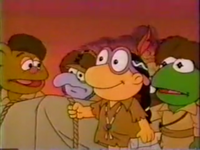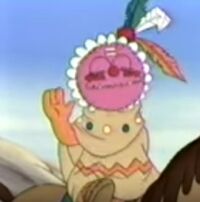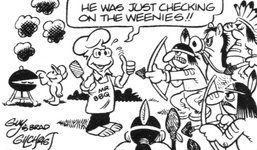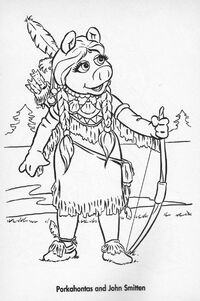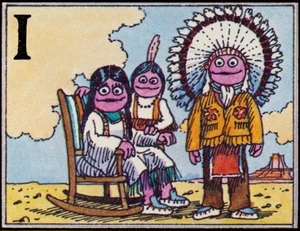
"I" is for "Indians" in "An American Alphabet."
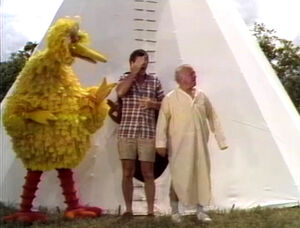
Big Bird visits the native people of Hawaii.
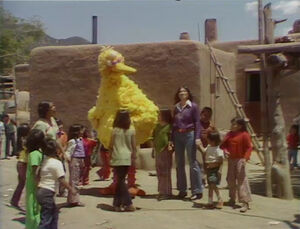
Big Bird visits the Pueblos of New Mexico.
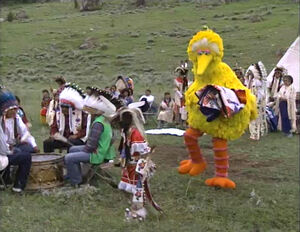
Big Bird visits the Crow of Montana.
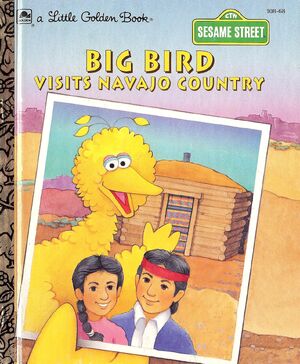
Big Bird visits the Navajo of Arizona.
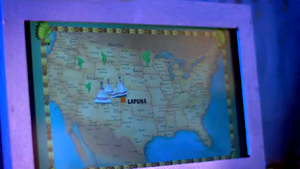
US map of (sometimes fictitious) Native American tribes on the German Sesamstrasse time travel special "Die Zeitmaschine" ("The Time Machine").
Native Americans (also known as American Indians and Indigenous Americans) are the pre-Columbian indigenous people of North America. Today, there are over 500 American Indian tribes, each with its own language and cultural traditions. The indigenous peoples of the Arctic are the Eskimo peoples. From tribe to tribe, there are large differences in clothing, housing, life-styles, and cultural practices.
Many portrayals of Native Americans in pop culture are oversimplified caricatures based on old stereotypes. They are often depicted in westerns fighting cowboys or in Thanksgiving pageants befriending the pilgrims. Some of the most common Hollywood images of Native Americans include wearing feathers and face paint, living in teepees, smoking peace pipes, carrying tomahawks and speaking in broken English with such phrases as "ugh" and "how".
Sesame Street featured the character of Buffy (played by Buffy Sainte-Marie). According to Sainte-Marie, this provided the opportunity to show viewers that "Indians still exist". She regularly appeared on Sesame Street over a five-year period from 1976 to 1981, along with her son, Dakota "Cody" Starblanket Wolfchild. Buffy and the cast visited Pueblos in New Mexico in 1975 and the show aired a week of episodes from Buffy's home in Hawaii in 1978. Sans Buffy, in 1991, the show focused on the American Indian culture with a series of episodes visiting the Crow Nation in Montana so that viewers could see "how American Indian children live" and spotlight the cultural similarities and differences among Native Americans.
Sesame Street[]
- Jim Henson's "Numerosity" series originally featured "ten little Indians" (with a young Brian Henson counting ten toy Indians). Sometime after its first broadcast, the part was replaced with "ten bells" (featuring a young John Henson as the counter).
- An animated insert for Sesame Street features a Native American boy telling two boys who are playing cowboys and Indians that, despite what they saw on TV, Indians don't say "ugh." (First: Episode 0771)
- The character of Buffy was played by Buffy Sainte-Marie who brought her Cree culture to the show -- including playing the mouth bow while singing such songs as "Cripple Creek" and "I'm an Indian," playing drum while singing "Listen to the Wind", and telling Cree stories to her son Cody (First: Episode 1292).
- Big Bird, Buffy, and Maria visited the Pueblos in New Mexico during a series of episodes in season 7. When they arrive at the pueblo, Maria confesses to Buffy that she's worried about intruding in the community, or making a mistake and that it must be easier for Buffy, because these are her people. Buffy explains that she's a Cree Indian, from Canada. There's about 300 different kinds of Indians, all with their own languages and customs. They're all visitors together. Buffy introduces Maria and Big Bird to her friends. Big Bird instantly makes friends with the kids. Before leaving, Big Bird says that he's had a good time at the pueblo, but he hasn't seen any Indians. Buffy tells Big Bird that everyone there is an Indian. Big Bird thinks they're fooling him: "I happen to know that Indians wear lots of feathers!" Buffy explains that Indians sometimes wear feathers on special occasions -- but then they take them off, and they wear clothes like everyone else. Big Bird says that someday maybe he'll take off his feathers and look like everyone else too.
- The cast of Sesame Street visited Buffy's home and the native people of Hawaii in a series of season 9 episodes. The group stays in Buffy's teepee on an Indian reservation. Buffy sings "I'm an Indian Wherever I Go" and expresses that no matter how long she lives in Hawaii, she still feels like a guest to the native Hawaiian people because they were here first.
- The Count demonstrates how to count in Sioux in a Season 9 insert. (First: Episode 1138)
- Big Bird, Oscar, The Count, Luis, and Maria visited the Crow Nation in Montana during a series of episodes in season 23. The group witness an authentic Crow Indian naming ceremony for 7-year-old Francis Bear Claw. Press material for the season reveled the episodes were part of a four-year curriculum focusing on race relations with season 23 focusing on the American Indian culture stating that "young viewers will get to see how American Indian children live and recognize general cultural similarities and differences among American Indian nations."[1]
- Big Bird visited the Navajo in Arizona in the storybook Big Bird Visits Navajo Country.
- A film insert shows the day in the life of a Native American child. (First: Episode 0153)
- An animated insert shows Native American bead designs displaying wild animals along with their Indian names. (First: Episode 2972)
- Herry Monster dressed as a Native American for a picnic with Oscar the Grouch, Grover, Bert, and Ernie dressed as pilgrims in the November spread of The Sesame Street Calendar 1972.
- The Sesame Street 1976 Calendar featured "Indians Welcome the Pilgrims to America" as the November spread. The calendar also featured "Indians" for the letter I in the center-fold of "An American Alphabet."
- Prairie Dawn dressed as a Native American on a Thanksgiving holiday card released in 1987.
- A series of animated inserts featured a skydiver jumping out of a plane while shouting "Geronimo!" (an exclamation that derived from a 1939 movie about the famed Apache leader).
- Grover visited the Inuit of Alaska, the natives of Hawaii, and the Navajo of Arizona in installments of "Global Grover."
International Sesame Street[]
- Ernie dressed as an Indian on the cover of Pregúntale a Sésamo Volume #5.
- An episode of Barrio Sésamo involved Espinete dressed as "el gran jefe indio" (translation: "the grand Indina chef"). He wears feathered headdress, sets-up a teepee, and beats a drum. (YouTube)
- Anke and Tiffy dressed as Indians in an episode of Sesamstrasse.
- In a "Ernie & Bert Show" segment of Sesamstrasse, Ernie insists that Indians have feathers and can fly. He goes so far as to put his Indian headdress on Bert to prove it.
- Bert dresses up as a Native American for a costume competition on the Eine Möhre für Zwei episode "Der Kostümwettbewerb" from 2016, reusing his best friend's headdress from the previously mentioned segment.
- In the Sesamstrasse spin-off TV-movie Die Zeitmaschine, Wolle and Pferd and their friend Emma visit the (fictitious) Native American Lapuna tribe.
- In the Sesamgade episode "Elmo får grønne fingre". Elmo's plants need water, so he tries to do a rain dance, that he read about in his book about Indians.
- A 1991 Jumbo Sesamstraat puzzle features Little Bird, Herry Monster, Ernie, Bert, Cookie Monster, Prairie Dawn, Grover, Betty Lou, and a pig camping in tipis, some of whom are wearing Native-styled headpieces.
- Live action segments on Canada's Sesame Street and Sesame Park included "Indian Friendship Dance" (production code 91E01), "Hoop Dancer" (99R08), "Northern Clothing/Winter" (91Y02), and "Native Culture/Yinkadene - Earth Poem" (92V15).
- Animation segments of Canada's Sesame Street and Sesame Park included "Native - Letter 'A'/Antlers" (94V11), "Native - Letter 'B'/Braid" (94V12), "Native - Letter 'E'/Eagle" (94V15), "Native - Letter 'G'/Games" (94V17), "Native - Letter 'H'/Headdress" (94V18), "Native - Letter 'I'/Inuit" (94V19), "Native - Letter 'J'/Jewellery" (94V20), "Native - Letter 'N'/Nature" (94V24), "Native - Letter 'O'/Ogopogo" (94V25), "Native - Letter 'P'/Peace" (94V26), and "Native - Letter 'W'/Wind" (94V33).
The Muppets[]
- Jimmy Dean and Rowlf the Dog dressed as Native Americans on The Jimmy Dean Show. In the February 20, 1964 episode, Rowlf appears with a long, feather top during the opening number ("Walk Right In") set in a Native American site. In the October 22, 1964 episode, Rowlf becomes an honorary chief of the Red Hawk Indian tribe and makes Jimmy an honorary member as well; the two sing "Pass That Peace Pipe" while dressed in Native American headdresses.
- Wayne and Wanda performed "Indian Love Call" in episode 106 of The Muppet Show but are interrupted by an Indian who thinks they are calling for him.
- Spike Milligan portrays a Native American in the closing number of episode 317 of The Muppet Show.
- Two Native American Whatnots were featured feuding with cowboys during the "Why Can't We Be Friends?" number in episode 401 of The Muppet Show.
- A group of Muppet dogs sing "Pass That Peace Pipe" in episode 414 of The Muppet Show. Despite the lyrics to "bury that tomahawk," the quartet are dispatched off one by one by hatchets and arrows.
- A Native American Whatnot appears during the finale of "Friendship Train" in episode 516 of The Muppet Show.
- Some Muppets mention "an Indian tent" as one of many types of homes in the song "Something for Everyone" for the Free to Be... a Family album.
- The Muppet Babies episode "Where No Muppet Has Gone Before" features Baby Skeeter portraying Sacagawea, the Native American woman who, at age 16, helped the Lewis and Clark Expedition in exploring the Louisiana Territory.
- The Muppet Babies episode "Transcontinental Whoo-Whoo" features Baby Animal portraying a Native American - he greets the others with a stereotypical "how" and guides them through the desert. Uncle Waldorf commented on Animal's appearance saying that "Indians were the first real Americans, you know? This land belonged to them before anyone else."
- Robin and Kermit accidently summon an angry group of Indians with the "smoke signals" from their barbecue in an August 17, 1983 installment of The Muppets Comic Strip (republished in Froggy Mountain Breakdown).
- Gonzo yells out "Geronimo" (a popularized exclamation that derived from a 1939 movie about the famed Apache leader that is now used by jumping skydivers or, more generally, anyone about to jump from a great height) twice in Muppet Treasure Island (once when exiting The Admiral Benbow Inn and again when jumping from The Hispaniola to attack the pirates on the island).
- Miss Piggy appeared as "Porkahantas" (a parody of Pocahontas) in the Great Muppets in American History coloring book.
- In the comic book "Muppet Peter Pan," the Electric Mayhem take over the role of the Indians of Neverland portraying a group of hippies named Firecheeks Floyd, His High Grooviness Dr. Goldentooth, Zoot Runningmouth, and He-Who-Runs-With-Sharks. Janice, who acts as the counterpart to Wendy from the original novel, is adopted into the collective and renamed "Tiger Lily".
Other[]
- On Dinosaurs, the Cavepeople served as a metaphor for Native Americans in the episode "The Discovery", in which the dinosaurs discover a new land inhabited by Cavepeople and cheat them out of it (but name their new baseball team after them).
- Frank Oz directed The Indian in the Cupboard (with visual effects by Jim Henson's Creature Shop). The film tells the story of a young boy who brings his toy Indian to life by placing him in a magic cupboard.
- Shadow tells the story of Squanto and the first Thanksgiving in Bear in the Big Blue House episode "The Best Thanksgiving Ever".
- Jim Henson's The Storyteller: Dragons graphic novel features the story of "The Son of the Serpent," inspired by Native American stories about the Horned Snake and the Thunderbird.
Sources[]
- ↑ Beaver Country Times: 'Sesame Street' family growing

